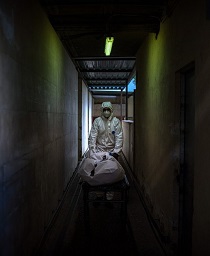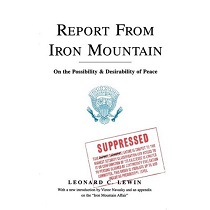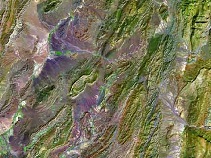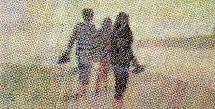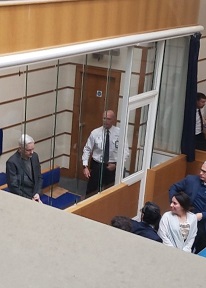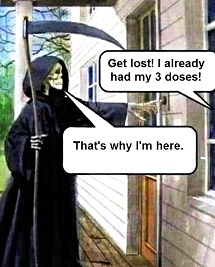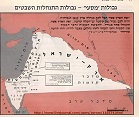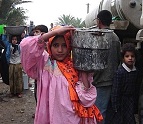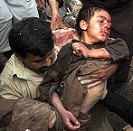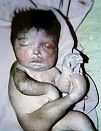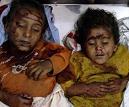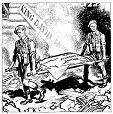And What Rough Beast Slouches Towards Gaza? - Operation Cast Lead and the Dismembering of a People
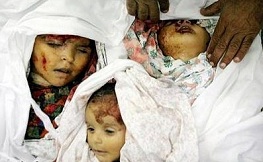
In early January 2009, two lone voices braved the Australian media to offer a differing view to that given by Government spokespersons regarding Operation Cast Lead, the 22-day assault of Israel on Gaza that began on December 27th 2008. The first was that of Greens Leader, Senator Bob Brown. He urged Julia Gillard to speak out against the "violent and disproportionate action by Israeli leaders." More pointed were the comments of Julia Irwin, Federal MP for the NSW seat of Fowler. In an article published in the Sydney Morning Herald at the time, she used metaphor to draw our attention to the travesty that was occurring in Gaza:
"It all reminds me of an old story from the days of the Roman Empire. The emperor Nero was upset that his prized lions were being distressed by Christians, who ran away from them in the Colloseum. Nero ordered that at the next circus, a Christian was to be buried up to his neck in the sand to make things easier for the lions. When the lions entered the ring, the biggest and the meanest saw the hapless condemned, swaggered over and stood astride the Christian’s head, roaring for approval from the crowd. At that moment, the Christian craned his neck and bit off the lion’s testicles. The crowd was shocked. "Fight fair! Fight fair!" they yelled."
Israel’s attack upon Gaza was met with a curious indifference by most of the so-called leaders of Western nations. As acting Prime Minister of Australia at the time, the ill-informed Julia Gillard refused to criticise, let alone condemn the actions of Israel. Supposedly speaking on behalf of the Australian people, she said: "Australia recognises the right of Israel to defend itself." That comment was made on the third of January 2009, by which time it was widely known that 430 Gazans had already been killed and 2,300 wounded in 750 individual strikes carried out by air and by sea over the previous five days.
Two years ago, we witnessed a stonehearted disregard of the humanity of those living in one of the most densely populated regions on the planet by one of the most powerful military forces on the earth. How can politicians so casually intone, "Israel has a right to defend itself"? Defend itself from what? From the miserable Qassam rockets that vent the rage of an immiserated group of Palestinian men, many of whose families have lost sons, daughters, freedoms and lands since the military occupation of Gaza by Israel that began in 1967? From the petulant stones hurled by boys and young men at the supremely armoured Merkava tanks that have blown apart their communities and knocked down their family homes?
There is much that underlies the grief and resentment that sears the minds of invulnerated Palestinians, much that has been ignored, suppressed and dismissed by those who would tell us what we should believe. Operation Cast Lead could not have happened without the widespread acceptance of a view that dismisses the essential humanity of the Palestinian people. How is it that so many in the West have come to perceive the Palestinians as a hostile race, a violent people, an unruly group with whom any reasoned and reasonable dialogue is impossible?
The late Edward Said spent most of his adult life in an impassioned quest to awaken our collective understanding to what has happened to the people of Palestine since their traditional lands were handed over to the newly created state of Israel in 1948 even as the embers of the Second World War had yet to cool. In a lecture delivered at the University of California at Berkeley eight months before he died in 2003, Edward Said reflected on the sorry fate of Palestinians since 1967:
"The thirty-five year old military occupation, now the longest and most brutally sustained in modern history has taken a terrific toll in the human condition of the Palestinians at every level. In fact, short of genocide itself, I cannot think of a single one of the human rights of the people that has not been violated with a kind of refined viciousness designed to dehumanise and break their spirit and humiliate them to a degree that is, even to someone who has been carefully but helplessly aware of what has been taking place, simply stupefying.
What has made it worse is how much of this has been wilfully shielded from witnessing eyes by propaganda about fighting for survival and against terrorism, claims that in any other instance, would defy the credulity of the most gullible intelligence."
Things have changed little since Said voiced these thoughts. The past eight years have seen a deepening rather than an easing of the plight of the people of Palestine, and more particularly, of the inhabitants of Gaza.
Edward Said was no armchair academic. He was a driving force in the creation of the Palestinian National Initiative, a democratic movement committed to providing Palestinians with an alternative identity to that offered by Yassar Arafat and his Fatah inner circle. Among Said’s collaborators in that project was Mustafa Barghouthi, a Palestinian doctor. In an article written two weeks after Israeli troops pulled out of a ruined Gaza in January 2009, Barghouthi offers a weepingly beautiful portrait of the Palestinian people and a clear restatement of both their identity and the character of their struggle. He reflects: "The main reason so much effort is put into distorting the character of Palestinians is that if the world were to really know what is going on here, the collective emotion would shift from apathy toward our struggle to one of anger at our oppressor."
One cannot understand the grievousness of what has happened in Gaza without understanding the depth of dispossession and the degree of oppression to which Palestinians have been subjected since the United Nations partitioned the British-ruled Palestine Mandate in November 1947. According to UN General Assembly Resolution 181, Israel was to be apportioned 55% of the mandated territory while the Palestinians were to be apportioned 45%. That never eventuated. Even before the Israeli land acquisitions of the Six Day War in 1967, the new state of Israel had sequestered 78% of Palestinian lands.
Between 1947 and 1951, more than 400 Palestinian villages were totally destroyed. As Jewish immigrants poured in from all over the world, nearly a million Palestinians were made homeless. Attacks by the Jewish army, the Haganah, and the ruthless Irgun, a militia group headed by Menachem Begin caused a massive exodus of Palestinians from their traditional lands. Reprisals occurred, the slaughters continued, waves of Palestinian refugees fled into neighbouring countries, and the Israelis took control of more lands. The slaughter of 120 Palestinians at Deir Yassin on April 9th 1948 and of 200 Palestinians at Tantura on May 15th 1948 were the earliest in a series of blood-lettings that extended from the Naqba, the Great Catastrophe, to the Sabra and Shatila massacres in Lebanon in 1982, the al Aqsa mosque massacre in 1990, the deaths at Jenin Refugee Camp in 2002, and most recently in the 750 civilian deaths that occurred in Operation Cast Lead.
The Soured Election
The more direct antecedents of Operation Cast Lead lie in the Palestinian elections of January 2006. These elections were largely driven by the Bush Administration in co-operation with the newly elected Mahmoud Abbas, who took over the presidency of the Palestinian National Authority after the death of the decrepit and opportunistic Yassar Arafat, founder of Fatah. Investigative journalist Chris Hedges comments on life in Gaza at that time:
"Gaza, ruled by warring factions, warlords, clans, kidnapping rings and criminal gangs, had descended into chaos under Mahmoud Abbas’ corrupt Fatah-led government".
Things did not go according to plan in those elections. On January 26th 2006, Hamas won 56% of the seats in the Palestinian Legislative Council. The US and Israel took immediate steps to "correct" the situation. Together with the European Union, Russia and the United Nations, the US demanded that the new Hamas government agree to accept the terms of all previous agreements made with Arafat’s Palestinian Authority and to formally recognise Israel’s right to exist. Hamas refused. The spigot was immediately turned off. All aid was immediately terminated. The newly elected government no longer had the means to fund its $2 billion annual budget. With over half of the Palestinian population living on under $2 a day at the time, there was no possibility of generating funds through such conventional methods as tax revenues.
Israel lost no time. It immediately tightened its border crossings and blocked all movement of Palestinians into and out of the Hamas-controlled Gaza Strip. The Israeli Defence Force (IDF) summarily rounded up and "arrested" over 60 Hamas officials including new ministers and Legislative Council members. The Israeli government was clearly displeased with the outcome of the elections.
Soon after, the Bush Administration followed suit when it learned that Mahmoud Abbas was engaged in discussions with Hamas about the possibility of forming a unity government. Condoleeza Rice travelled to Ramallah to sort things out. In early October 2006, she instructed Abbas to do whatever was necessary to dissolve the Hamas-led government as soon as possible and to prepare the ground for a new election.
Several weeks passed and nothing had happened. Mahmoud Abbas was delivered a thinly disguised ultimatum by the US State Department. It read, "We need to understand your plans regarding a new [Palestinian Authority] government . . . You told Secretary Rice you would be prepared to move ahead within two to four weeks of your meeting. We believe that the time has come for you to move forward quickly and decisively." (Quoted by David Rose, Vanity Fair, April 2008)
Tensions between Hamas and Fatah turned deadly as Hamas learned of the collaborations between Fatah and Washington. Fighting broke out on multiple fronts. By December 2006, dozens were being killed every month. Meanwhile, Condoleeza Rice had arranged a series of meetings and discussions with the leaders of Egypt, Jordan, Saudi Arabia and the United Arab Emirates. David Rose comments: "She asked them to bolster Fatah by providing military training and by pledging funds to buy its forces lethal weapons. The money was to be paid directly into accounts controlled by President Abbas."
Before year’s end, four trucks loaded with 2,000 Egyptian-made automatic rifles, 20,000 ammunition clips and two million bullets were quietly ushered from Egypt into Gaza through an Israeli-controlled crossing. Their deadly cargo was delivered to Fatah officials. At much the same time, the United Arab Emirates handed over cash payments of between 20 and 30 million dollars to Fatah.
The new hardware from Egypt was put to use within weeks. By early February, Fatah forces stormed the Islamic University of Gaza, which was viewed as a Hamas stronghold, and torched several buildings. Hamas responded by attacking Fatah-controlled police stations.
With Gaza on the verge of a full-blown civil war, King Hussein of Saudi Arabia quickly convened a meeting. Abbas and his US-appointed national security advisor met with a group of Hamas Leaders in Mecca. As a result of the meeting, Fatah members were offered several key posts in the Legislative Council, and a national unity government was formed. The Saudis agreed to pick up the tab for the Palestinian Authority’s bills, which had not been paid for over 12 months. The celebrations that followed were, however, to be short-lived.
Incensed at this development, the US drew up a plan to provide Mahmoud Abbas and his Fatah forces with $1.27 billion dollars in military training, hardware and salaries over the following five years in exchange for an assurance that he would "collapse the government" in accordance with the wishes of the US and Israel. Details of this plan were unexpectedly leaked to a Jordanian newspaper on April 30, 2007. Within days, Hamas had become aware that a US-backed Fatah coup was in the making.
In mid May, five hundred Fatah National Security recruits crossed the Egyptian border in new outfits sporting new weaponry and driving new armoured vehicles. An observer commented: "They had new rifles with telescopic sights, and they were wearing black flack-jackets. They were quite a contrast to the usual scruffy lot." Hamas fighters tried to intercept these new recruits as they crossed into Gaza but were pushed back by the tight discipline of the new Fatah recruits. By the end of May, Hamas and the newly armed Fatah security forces were at each other’s throats.
The camel’s back was completely broken on June 7th when the Israeli newspaper Haaretz revealed that an even larger shipment of Egyptian arms was ready to be shipped to Fatah forces. David Rose reports:
"Abbas and Dayton [the US security co-ordinator for the Palestinians] had asked Israel to authorise the biggest Egyptian arms shipment yet - to include dozens of armoured cars, hundreds of armour-piercing rockets, thousands of hand grenades, and millions of rounds of ammunition."
With over 250 Hamas members having already been killed in the previous six months, Hamas decided to put an end to it there and then.
It was all over within a few days. The Fatah security forces were routed and ruthlessly cut down by Hamas fighters. Mahmoud Abbas dissolved the nascent and barely-formed Palestinian Authority-Hamas unity government a week later. Hamas claimed full control of Gaza on June 15th 2007. Those within Fatah who managed to survive the deadly battle of Gaza limped back to Abbas’ new stronghold, the Israeli-occupied territory of the West Bank. The US and Israel were satisfied that the West Bank and Gaza were now fully isolated from each other. And the blood spilt and damage done during that sad episode was but a minor prelude to what was to be unleashed on Gaza eighteen months later by the IDF in Operation Cast Lead.
Tightening the Stranglehold
Gaza was declared a 'hostile entity’ by the Israeli Security Cabinet, and the blockade of Gaza was intensified. Israeli forces closed all portals of entry and Egypt followed suit at its northern border with Gaza. The movement of people and of goods into and out of Gaza was frozen. Overnight, Gaza had become totally ghettoised. Predictably, Hamas resumed its useless rocket attacks on southern Israel.
By December 2007, 90% of the functioning factories and workshops in Gaza had closed down. With the blocking of all imports into Gaza, there were simply no materials available to work with any more. The income of 70% of the population of the Gaza Strip had by then dropped to below $2 a day.
By June 2008, the situation of ordinary Gazans had become intolerable. The year-long Israeli blockade had cut off supplies of all the vital materials whereby civil society could be sustained. In desperation, Hamas sought ways of breaking the Israeli stranglehold of its borders. Through talks mediated by the Egyptian government, an agreement was reached whereby Hamas offered to end the firing of rockets into Israel in exchange for an easing of the blockade at the borders. A cease-fire was agreed upon on July 19th 2008. All Hamas rocket fire ceased immediately. But in the words of Chris Hedges,
"Israel never upheld its end of the agreement. It increased the severity of the siege."
A year earlier, in May 2007, nearly 11,000 trucks carrying goods crossed the Israeli controlled border-posts into Gaza each month. These provided essential materials – food, medicines, building materials, industrial supplies, educational items, clothing and technology – to serve the needs of Gaza’s one and a half million inhabitants. By October 2008, the number had dropped to under 3,000 trucks each month. During the month of November 2008, the month before Operation Cast Lead was launched, Israel allowed only 579 trucks to cross the border.
Israeli planners had learned well from the strategic course charted by George Bush Senior, Bill Clinton and George Bush Junior in Iraq. Weaken the enemy to the point of abject impotence through blockades and sanctions, and when they have become totally defenceless, unleash all hell with the deadliest military hardware this planet has ever seen. By the end of January 2009, the results in Gaza mirrored those in Iraq. Broken buildings, broken bodies and untold numbers of grieving mothers, fathers and children.
The Preparations
The cease-fire agreement of July 2008 between Israel and Hamas lasted only four months. It was broken by an Israeli military strike on Hamas on November 4th 2008. Richard Falk, Professor Emeritus of International Law at Princeton University and UN Special Rapporteur on Palestinian human rights reflected on the event: "A temporary ceasefire between Israel and Hamas that had been in effect since 19 July 2008 had succeeded in reducing cross-border violence virtually to zero; Hamas consistently offered to extend the ceasefire, even to a longer period of ten years. The breakdown of the ceasefire . . . came about mainly as a result of an Israeli air attack on 4 November that killed six Hamas fighters in Gaza."
The Israeli game plan had, however, been set long before the July cease-fire agreement. Israeli military planners bided their time until the opportune moment. That moment happened to coincide precisely with the day of the US elections, November 4, 2008. The Israeli military knew well that their attack would not appear on the front page of any newspaper outside of the Arab world.
On November 5th, the siege of Gaza became absolute. Israel completely shut down the borders. Predictably, useless rockets and mortars were once again launched across the border from Gaza into Israel. This was precisely what the Israeli military had counted on.
The rest moved like clockwork. F-16 fighter jets and Apache helicopters were loaded with precision missiles and messy bombs; Israeli navy attack ships lined up off the Gaza coast-line; and earth-shaking battalions of Merkeva tanks were set rolling together with their well-armed ground troops as the pyrotechnics were about to unfold.
The Deadly Visitation
In the days after Christmans 2008, volley upon volley of monstrous weapons shredded the skies of Gaza, a tiny, densely populated strip of land 8 kilometres wide and 45 kilometres long. On January 4th, the sour-mouthed Israeli President Shimon Peres said: "Israel’s aim was to provide a strong blow to the people of Gaza so they would lose their appetite for shooting at Israel." That strong blow was relentlessly delivered. It resulted in the death of over 240 children under the age of sixteen, the death of hundreds of non-combatant men and women, the wounding of five thousand others and the creation of enduring psychological terror for tens, if not hundreds of thousands of Palestinians.
The Israeli soldiers returned to their homes and barracks. The bloodied mess of broken bodies and broken roads and buildings was left for the people of Gaza to deal with.
There is a peculiar cynicism hidden in the events leading up to Operation Cast Lead. Ariel Sharon callously oversaw the massacres at the Sabra and Shatila refugee camps in Lebanon in 1982. Two decades later, the haughty George Bush Junior lauded him as a "man of peace". A year after that ludicrous statement was made, Sharon’s apparent prince-hood was confirmed in the minds of many by his order to dismantle all Jewish settlements in the Gaza Strip and to evacuate the 7,000 Israeli "settlers" who had illegally claimed lands in Gaza under the protective mantle of well-armed Israeli Defence Force guards.
The attack upon Gaza in December 2008 could never have happened without Sharon’s emptying of Gaza of its Israeli inhabitants four years earlier. The captive native population was thereby laid open to a continuous disgorgement of lethal weaponry by the Israeli military in Operation Cast Lead.
Israel has in recent decades become a major developer and manufacturer of sophisticated weapons. But most of its military hardware has been supplied over several decades by the US. After the Vietnam debacle in the 1970s, Israel stepped up to the pad as the next major recipient of US military aid. It has retained that position ever since.
Israel has been gifted over two billion dollars every year - most of it in the form of military "assistance" - by the US for decades now. The Bush administration alone provided over 21 billion dollars in "security assistance" during its time in office. In addition to these lethal gratuities, Israel has more recently signed contracts with US arms manufacturers for over 22 billion dollars of new military hardware. This includes a deal for 75 Joint Strike Fighters, 9 military transport aircraft and 4 combat ships.
Israel presently has 180,000 heavily armed regular troops in their armed forces, 140,000 conscripts, 4,300 impenetrable Merkava battle tanks, 10,000 light tanks and armoured cars, 500 missile-laden fighter jets, 1340 helicopters, three submarines, three destroyers and 40 smaller warships. And the full might of Israeli military force was projected into the tiny space of Gaza during the three week period from December 27th 2008 to January 18th 2009.
In February 2009, investigative journalist Conn Hallinan was to describe Gaza as "Death’s Laboratory." Israel’s new weapons had caused injuries never before seen in the hospitals of Gaza. Many of these were the result of the widespread use of a new class of weapons called Dense Inert Metal Explosive (DIME). These were initially developed by the US Air Force and scientists from the University of California’s Lawrence Livermore Laboratory nine years ago. DIME weapons consist of a high explosive core around which is wrapped powdered tungsten alloy in a carbon fibre container. On detonation, the tungsten sprays out explosively over a ten-meter radius shredding everything in its field. The resultant injuries are truly shocking.
Norwegian doctor Mads Gilbert commented: "The muscles are sort of split from the bones, hanging loose, and you also have quite severe burns. . . . Those inside the perimeter of this weapon’s power zone will be torn completely apart. We have seen numerous amputations that we suspect have been caused by this." He went on to say, "I’ve never seen anything as bad as that. I have been to many conflict zones. I was in Beirut in 1982 . . . but Gaza was the worst."
A German doctor working in southern Gaza offered his own observations: "Initially, everything seems in order. . . But it turns out on operation that dozens of miniature particles can be found in all their organs." Most of those who survive the shredding of their limbs succumb soon after to septicaemia and organ collapse. Habas Al-Wahid, head of emergency at a Gaza hospital observed that in several cases of DIME-caused injuries, the legs of the injured were sliced from their bodies "as if a saw was used to cut through the bone."
Are these the intended fruits of human ingenuity, of our capacity for deep intelligence, of our mastery of the art of technological innovation?
The longer-term consequences of the use of tungsten-based weapons have yet to be realised. Like depleted uranium, which has caused numerous cancers and monstrous birth deformities in Iraq, aerosol tungsten will doubtless bring its own train of future woe. Conn Hallinan reports that it has already been implicated as a possible cause of leukaemia and other cancers.
The DIME weapons used in Gaza were either supplied directly to Israel by the US or were manufactured in Israel under US instructions. They have yet to be banned under the Geneva Conventions because - until Gaza - they had yet to be systematically "tested" on a living population. Despite all pleas to the contrary and claims of good conduct by Israel, the war upon Gaza, like all wars, was yet another act of profound lawlessness and deceit.
The use of phosphorus-based weapons near populated areas has long been prohibited under international law. But this did not prevent the use of such weapons by Israel. Suspicions were raised early when, in addition to the hundreds of half-ton "conventional" bombs that rained upon Gaza every day, the characteristic spray of burning white phosphorus streaking through the sky began to be noticed in some of the airbursts. Within a short time, people arrived in casualty wards of Gaza with horrible burns that continued to smoke and smoulder even after they had been washed and bandaged.
During the first week of Israel’s offensive, journalists from the UK Times identified row upon row of American-made pale blue M825A1 white phosphorus artillery shells from high-resolution images of Israeli artillery units on the Israeli-Gaza border. Their reports were met with strident denials by IDF spokespersons. This echoed the Israeli denials three years earlier of having used phosphorus against civilian targets in Lebanon. They lied in August 2006 and they lied again in January 2009. But that is all part of how war is conducted by civilised nations in obscene times.
On 11th January 2009, IDF spokeswoman Major Avital Leibovich stated: "I can assure you we do not use any weapons that are prohibited by international law. There are other nations that use phosphorus bombs, and we have the right not to comment on this." She was probably referring to the fact that both Britain and the US used white phosphorus in Iraq, especially during the Fallujah campaign. So the fact of one obscenity is thereby used to justify another.
Another weapon used in Gaza was the newly developed GPS-guided mortar. The GPS mortar was developed by the Israeli weapons industry working closely with the US company Alliant. GPS mortars are equipped with satellite navigation systems and are said to act with surgical precision. Yet they were found sorely wanting. Israeli journalist Amira Hass reported that during the second week of January, such a weapon missed its intended target by 30 meters and slammed into a United Nations Relief and Works Agency school where many women and children had sought refuge. It killed 30 of them outright. Another 10 women and children died of their injuries later. Many others sustained horrendous injuries.
After months of back-room negotiations, the US agreed to supply Israel with 1,000 GBU-39 bombs in September 2008. These new weapons had been developed and assembled by the Boeing Corporation. The GBU-39 is designed to penetrate deep into the earth before exploding. Arrays of these new weapons were delivered in early December. Within the first hours of the Israeli offensive, hundreds of GBU-39 bombs had been dropped on Rafa in an attempt to destroy the network of tunnels that enabled the movement of essential goods and materials from Egypt into Gaza.
Cold Spin
The assault upon Gaza was many months in the making. Steven Zunes reported in May 2009:
"Israeli Defence minister Ehud Barak admitted that the Israeli invasion had been planned for months, back when a six-month cease fire was still in effect."
Not a single Hamas rocket had been fired into Israel from the time the cease-fire was declared on June 18th 2008 and the deadly truce-breaking Israeli air attack in Gaza on November 4th 2008 that killed six Hamas members. Steven Zunes observes that in spite of the predictable and cynically anticipated resumption by Hamas of cross-border rocket fire, "not a single Israeli had been killed by rocket attacks for more than half a year prior to Israel launching its war on December 27." The planning for Operation Cast Lead was well under way in March 2008. It was fully in place many months before the actual assault. The IDF was therefore militarily well prepared for the December 27 assault. So too was its public relations arm. Like the GBU-39 bombs at Rafa, silver-tongued commentators miraculously and simultaneously appeared in the major media outlets throughout the Western world.
In an impassioned piece entitled "Israel’s Lies" published in the London Review of Books on January 29th 2009, Henry Seigman, former national director of the American Jewish Congress inveighed:
"Western governments and most of the Western media have accepted a number of Israeli claims justifying the military assault on Gaza: that Hamas consistently violated the six-month truce that Israel observed and then refused to extend it; that Israel therefore had no choice but to destroy Hamas’s capacity to launch missiles into Israeli towns; that Hamas is a terrorist organisation, part of a global jihadi network; and that Israel has acted not only in its own defence but on behalf of an international struggle by Western democracies against this network.
I am not aware of a single major American newspaper, radio station or TV channel whose coverage of the assault on Gaza questions this version of events. . . Middle East peacemaking has been smothered in deceptive euphemisms so let me state bluntly that each of these claims is a lie."
Those lies were swallowed up whole by the Western world.
Even as the tanks began rolling and the bombs were exploding, Israeli Foreign Minister Tzipi Livni instructed her minions to engage foreign language speakers everywhere to take "emergency measures to adapt Israel’s public relations to the ongoing escalation in the Gaza Strip." (Julia Irwin, "Getting Away with Murder", Sydney Morning Herald, 11/1/09) Within hours, the smooth-voiced Israeli spokesman Mark Regev and Martin Indyk, a former official of the American Israel Public Affairs Committee, were everywhere to be heard on Radio National and the ABC network throughout Australia.
UK journalist Robert Fisk happened to be travelling through Canada at the time the offensive was launched. He noted that numerous articles attempting to justify Israel’s actions by asking readers to imagine the horror of coming under Palestinian rocket attack began to appear simultaneously in large-circulation newspapers. He commented:
"I’m waiting for the same writers to ask how we’d feel if we . . . came under sustained attack from supersonic aircraft and Merkava tanks and thousands of troops whose shells and bombs tore 40 women and children to pieces outside a school, shredded whole families in their beds and who, after nearly a week, had killed almost 200 civilians out of 600 fatalities."
US journalist Chris Hedges similarly railed:
"The use of attack aircraft and naval ships, part of the world’s fourth-largest military power, to level densely packed slums of people who were hungry, without power and often water, people surrounded on all sides by the Israeli army, was fatuously described as a war. The news coverage held up the absurd notion that a few Hamas fighters with light weapons and no organization were a counterforce to F-16 fighter jets, tank battalions, thousands of Israeli soldiers, armoured personnel carriers, naval ships and Apache attack helicopters. It fit the Israeli narrative. It may have been balanced and objective. But it was not true."
The attack upon Gaza was clearly part of a longer-term project for the complete subjection of Palestinians by Israel. The attack was not an act of self-defence against miserable Qassam rockets. As Ben White spointed out:
"During the truce last year, rocket fire from the Gaza Strip was reduced by 97%, with the few projectiles that were fired coming from non-Hamas groups opposed to the agreement."
The breaking of the ceasefire by the Israelis on November 4th was a deliberate and provocative act that brought the expected response from Hamas. The Israelis bided their time in order to teach the Gazans a lesson for choosing Hamas during the 2006 elections. The ferocity and the duration of Operation Cast Lead was intended to destroy Hamas and to humiliate the Palestinians of Gaza who had deigned to chose Hamas as their representatives.
Even before Operation Cast Lead, the Gazans were already near-broken by the debilitating Israeli blockade of their border crossings. The compliant Mahmoud Abbas and his shadowy Fatah officials had been sequestered into what is left of the West Bank to make sure that the Palestinians there did not get too rowdy or emotional about what was happening in Gaza. Most Western leaders chose to look aside and chorused in unison about the Right of Israelis to Defend Themselves while the Israeli military set about systematically destroying every civil institution and every form of essential infrastructure necessary for the conduct of life, a life that for Gazans had already been made near intolerable.
There are probably also other factors behind Operation Cast Lead apart from the desire to destroy the will of the Palestinians of Gaza and to "catastrophise" their experience of life. In a more cynical vein, we would do well to remember that the Israelis have for many years coveted the huge reservoirs of undersea natural gas in Gaza’s territorial waters that were discovered by the British Gas Group about a decade ago. This side of things may come increasingly to light in coming time as Israel attempts to secure additional sources of energy during this time of dwindling reserves.
The Continuing Impasse
During the 22 days of Operation Cast Lead, 20,000 buildings and 5,000 homes throughout Gaza were completely destroyed leaving over half a million metric tonnes of debris, much of which has yet to be cleared. The Israelis targeted every part of the territory’s infrastructure. Erin Cunningham observed:
"Homes, businesses, factories, power grids, sewage systems and water treatment plants were reduced to piles of rubble across the Gaza Strip."
Seven schools in Gaza were totally destroyed, and 135 were substantially damaged. The Al-Azhar University of Gaza was reduced to rubble. Hospitals, medical clinics and Red Crescent warehouses were all targeted, as was every police station and every building associated with Hamas activities. Over 250 civilian Palestinian policemen were killed during the 22-day operation. George Bisharat documents how Israeli military lawyers went so far as to authorise the bombing of a police cadet graduation ceremony, killing 63 young Palestinian men in a single strike.
Even though 70% of Gaza’s agricultural system had been rendered useless by the Israeli border siege which had blocked the entry of pipes and pumps essential for irrigation, Israeli tanks and bulldozers set about ruining what little was left. Vast acreages of farming land including olive orchards, fruit plantations, chicken farms and other established farms throughout Gaza were systematically destroyed.
According to a particular view, Operation Cast Lead represented the face of a new and compassionate style of warfare where the dead are counted in the thousands rather than tens or hundreds of thousands; where the entire population is reduced to immiserated subjection rather than starvation unto death; where all the institutional forms necessary for the conduct of civil society are broken apart rather than being totally incinerated and destroyed; where all such actions are claimed to be fair and just and necessary for self-protection.
Among the first to speak loudly and passionately about the criminality of Israel’s actions was Richard Falk, UN special rapporteur on the Palestinian territories. As the first Israeli bombs exploded on December 27th, Falk drew attention to the massive violation of international humanitarian law that was happening in Gaza. He called upon the United Nations to halt Israel’s actions and to immediately provide protection for the Palestinian people. But for decades now, neither the wishes nor the resolutions of the United Nations have tempered the actions of Israel towards Palestinians. Falk was later to write:
"The focus of legal debate should not be upon whether Israeli force was disproportionate. Of course it was. The focus should be on whether the Israeli attacks were a prohibited non-defensive use of force under the UN charter, amounting to an act of aggression, and as such, constituting a crime against peace. . . .
Israel initiated the Gaza campaign without adequate legal foundation or just cause, and was responsible for causing the overwhelming proportion of devastation and the entirety of civilian suffering" (Le Monde Diplomatique, 12/3/09).
Soon after, George Bisharat, professor of Law at the University of California published a series of articles in US newspapers detailing how international law had been brutalised by Israel in its 22-day assault upon Gaza. He describes how Israeli lawyers deliberately manipulate legal process to achieve their desired ends. Quoting Daniel Reisner, former head of Israel’s 20-lawyer International Law Division in the Military Advocate General’s office, he showed how powerful lawyers acting in concert can effectively change the rules:
"If you do something for long enough, the world will accept it. The whole of international law is now based on the notion that an act that is forbidden today becomes permissible if executed by enough countries. . . . International law progresses through violations. We invented the targeted assassination thesis and we had to push it. At first there were protrusions that made it hard to insert easily into the legal molds. Eight years later, it is in the centre of the bounds of legitimacy" ("Israel: Transforming International Law by Violating It", San Francisco Chronicle, 1/4/09).
Yet there are some lawyers who are more driven by ethical considerations than a will to serve political ideologies. In early February 2009, a group of eight American lawyers, all members of the National Lawyers Guild in the US visited and reported on their observations of the situation in Gaza. They confirmed that the IDF had fired missiles at UNRWA schools in Gaza City, Jabalyia and Bet Labiya. They expressed deep concern at the use of white phosphorus, DIME munitions and other prohibited weapons and at "the use of conventional weapons in a prohibited manner, specifically, the use of battlefield weapons in densely populated civilian areas."
All eight members of the Delegation called upon both Israel and the US - which supplied most of the weapons used in the assault – to be held accountable for the criminality of their actions.
Remembering Gaza
The horror of Gaza cannot be dismissed as a distant phenomenon that does not concern us. We may withdraw into our own complacency and comfort, but in truth, no one is exempted from the pain visited upon innocent households. No one can evade the consequences of the destructive exercise of brutal force.
The immense yet subdued anguish, the heavy-hearted impotence that weighs on so many, the outraged sense of justice at the grotesque disproportionality of the violence we have witnessed, the travestying of all norms of reasonable human conduct will neither pass nor be forgotten.
The assault upon Gaza has done nothing to further the making of peace in Palestine. It has done much to deepen resentments that will find their own tragic and futile expressions in time to come. No cheek has been turned at any stage in the volleys of violence that have shaken the Holy Land for more than half a century. And little regard has been given to the humanity of the generations swept into a gathering maelstrom fired by a cold and calculated demonic determination.
There is more that could be said, and more, perhaps, that should be said about how the people of Gaza have been manacled since 1993 when Israel closed the borders and "managed" the movement of people and goods into and out of Gaza; about the 44 year long occupation of Gaza, the West Bank and East Jerusalem; about the wholesale separation and isolation of the Palestinians of Gaza from their fellow Palestinians in the West Bank; about the progressive cantonisation of the West Bank by the relentless construction of militarily-protected illegal "settlements"; about the "security barriers" that have drawn and quartered any semblance of autonomous life and culture for all Palestinians; about the forced impoverishment, reduced access to markets, and forfeited freedoms of all Gazans. The betrayal of Gaza represents not only a failure of justice, but also a failure of the human spirit.
Let us continue to remain vigilant regarding further movements in the Middle East as the seams that hold the phenomenal world together everywhere begin to stretch to their limits.
___________________________________________________________________________________
Vincent Di Stefano is a retired osteopath and author of "Holism and Complementary Medicine. History and Principles" published by Allen and Unwin in 2006. He lives in Australia and can be contacted at www.thehealingproject.net.au
___________________________________________________________________________________
Source: CommonDreams.org. Photo: uruknet.info
URL: http://www.a-w-i-p.com/index.php/2010/12/29/and-what-rough-beast-slouches-towards-ga

